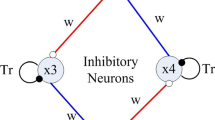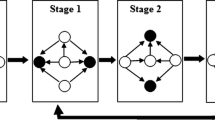Abstract
Can one develop an abstract description of the dynamics of pattern generators that provides quantitative insight into their operation? We explored this question by examining the dynamics of a model central pattern generator that was created using an evolutionary algorithm. We propose an abstract description based on the concept of a dynamical module, a set of neurons that simultaneously make their transitions from one quasistable state to another while the synaptic inputs that they receive from other neurons remain essentially constant, thus temporarily reducing the dimensionality of the circuit dynamics. Using the mathematical tools of dynamical systems theory, we describe a method for identifying dynamical modules and demonstrate that this concept can be used to quantitatively characterize constraints on neural architecture, account for phase durations, and predict the effects of parameter changes. Moreover, this abstract description reveals coordinated parameter changes that leave the overall circuit dynamics essentially unchanged. In a companion article we employ this abstract description to examine the relationship between general principles and individual variability in large populations of evolved model pattern generators.
Similar content being viewed by others
References
Abraham RH, Shaw CD (1992) Dynamics: The Geometry of Behavior. Addison-Wesley, Redwood City, CA.
Beer RD (1995) On the dynamics of small continuous-time recurrent neural networks. Adaptive Behavior 3(4): 471–511.
Beer RD, Chiel HJ, Gallagher JC (1999) Evolution and analysis of model CPGs for walking II. General principles and individual variability. This issue.
Beer RD, Gallagher JC (1992) Evolving dynamical neural networks for adaptive behavior. Adaptive Behavior 1(1): 91–122.
Casey M (1996) The dynamics of discrete-time computation, with applications to recurrent neural networks and finite state machine extraction. Neural Comp. 8: 1135–1178.
Cohen A, Ermentrout GB, Kiemel T, Kopell N, Sigvardt KA, Williams TL (1992) Modelling of intersegmental coordination in the lamprey central pattern generator for locomotion. Trends Neurosci. 15: 434–438.
Doya K (1997) Near-saddle-node bifurcation behavior as dynamics in working memory for goal-directed behavior. Neural Comp. 10: 113–132.
Ferré TC, Marcotte BA, Lockery SR (1996) Neural network models of chemotaxis in the nematode Caenorhabditis elegans. In: Touretzky DS, Mozer MC, Hasselmo ME, eds. Advances in Neural Information Processing Systems 9, Morgan Kaufmann, San Mateo, CA. pp. 55–61.
Funahashi K, Nakamura Y (1993) Approximation of dynamical systems by continuous time recurrent neural networks. Neural Networks 6: 801–806.
Getting P (1989) Emerging principles governing the operation of neural networks. Ann. Rev. Neurosci. 12: 185–204.
Hirsch M (1989) Convergent activation dynamics in continuous time networks. Neural Networks 2: 331–349.
Hopfield JJ (1984) Neurons with graded response properties have collective computational properties like those of two-state neurons. Proceedings of the National Academy of Sciences 81: 3088–3092.
Katz PS, Frost WN (1996) Intrinsic neuromodulation: Altering neuronal circuits from within. Trends Neurosci. 19: 54–61.
Kiehn O, Eken T (1998) Functional role of plateau potentials in vertebrate motor neurons. Curr. Opin. Neurobiol. 8: 746–752.
Kleinfeld D, Sompolinsky H (1988) Associative neural network model for the generation of temporal patterns: Theory and application to central pattern generators. Biophys. J. 54: 1039–1051.
Kleinfeld D, Sompolinsky H (1989) Associative network models for central pattern generators. In: Koch C, Segev I, eds. Methods in Neuronal Modeling. MIT Press, Cambridge, MA. pp. 195–246.
Kopell N, Ermentrout GB (1990) Structure and function in an oscillating neural network. In: Schwartz EL, ed. Computational Neuroscience. MIT Press, Cambridge, MA. pp. 201–209.
Lee RH, Heckman CJ (1998) Systematic variation in bistability among spinal motoneurons in vivo: Rhythmic firing patterns. J. Neurophysiol. 80: 572–582.
Llinás RR (1988) The intrinsic electrophysiological properties of mammalian neurons: Insights into central nervous system function. Science 242: 1654–1664.
Lockery SR, Sejnowski TJ (1992) Distributed processing of sensory information in the leech. III. A dynamical neural network model of the local bending reflex. J. Neurosci. 12: 3877–3895.
Marder E, Calabrese RL (1996) Principles of rhythmic motor pattern generation. Physiol. Rev. 76: 687–717.
Partridge LD, Benton LA (1981) Muscle, the motor. In: Brooks VB, ed. Handbook of Physiology, Section 1: The Nervous System, Vol. II, Motor Control. Part 1. American Physiological Society, Bethesda, MD. pp. 43–106.
Roberts PD (1998) Classification of temporal patterns in dynamic biological networks. Neural Comp. 10: 1831–1846.
Roehrig CJ (1997) Dynamics of the C. elegans reversal maintenance circuit: Engineering a dynamical system for control. Proc. IEEE Conf. Systems, Man and Cybernetics, IEEE, Orlando, FL, pp. 3007–3012.
Rowat PF, Selverston AI (1993) Modeling the gastric mill central pattern generator of the lobster with a relaxation-oscillator network. J. Neurophysiol. 70: 1030–1053.
Skinner FK, Kopell N, Marder E (1994) Mechanisms for oscillation and frequency control in reciprocally inhibitory model neural networks. J. Comput. Neurosci. 1: 69–87.
Strogatz SH (1994) Nonlinear Dynamics and Chaos. Addison-Wesley, Reading, MA.
Wang X-J, Rinzel J (1992) Alternating and synchronous rhythms in reciprocally inhibitory model neurons. Neural Comp. 4: 84–97.
Wilson HR, Cowan, JD (1972) Excitatory and inhibitory interactions in localized populations of model neurons. Biophysical Journal 12: 1–24.
Zhaojue Z, Schieve WC, Das PK (1993) Two neuron dynamics and adiabatic elimination. Physica D 67: 224–236.
Author information
Authors and Affiliations
Rights and permissions
About this article
Cite this article
Chiel, H.J., Beer, R.D. & Gallagher, J.C. Evolution and Analysis of Model CPGs for Walking: I. Dynamical Modules. J Comput Neurosci 7, 99–118 (1999). https://doi.org/10.1023/A:1008923704408
Issue Date:
DOI: https://doi.org/10.1023/A:1008923704408




